BAP11 Principles of Accounting: Cash Flow Statement Analysis 2018
VerifiedAdded on 2023/06/09
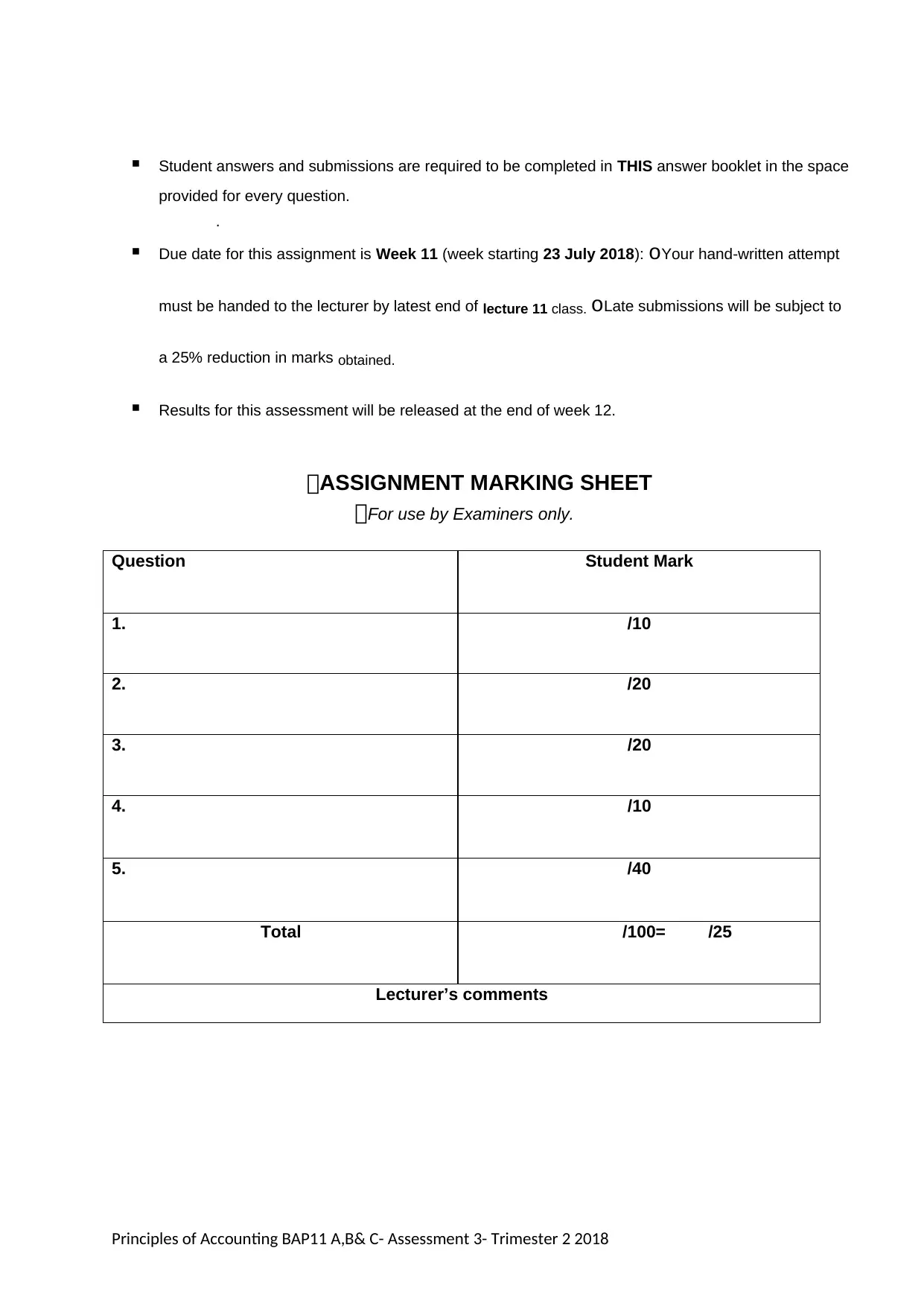
provided for every question.
.
Due date for this assignment is Week 11 (week starting 23 July 2018): oYour hand-written attempt
must be handed to the lecturer by latest end of lecture 11 class. oLate submissions will be subject to
a 25% reduction in marks obtained.
Results for this assessment will be released at the end of week 12.
ASSIGNMENT MARKING SHEET
For use by Examiners only.
Question Student Mark
1. /10
2. /20
3. /20
4. /10
5. /40
Total /100= /25
Lecturer’s comments
Principles of Accounting BAP11 A,B& C- Assessment 3- Trimester 2 2018
Paraphrase This Document
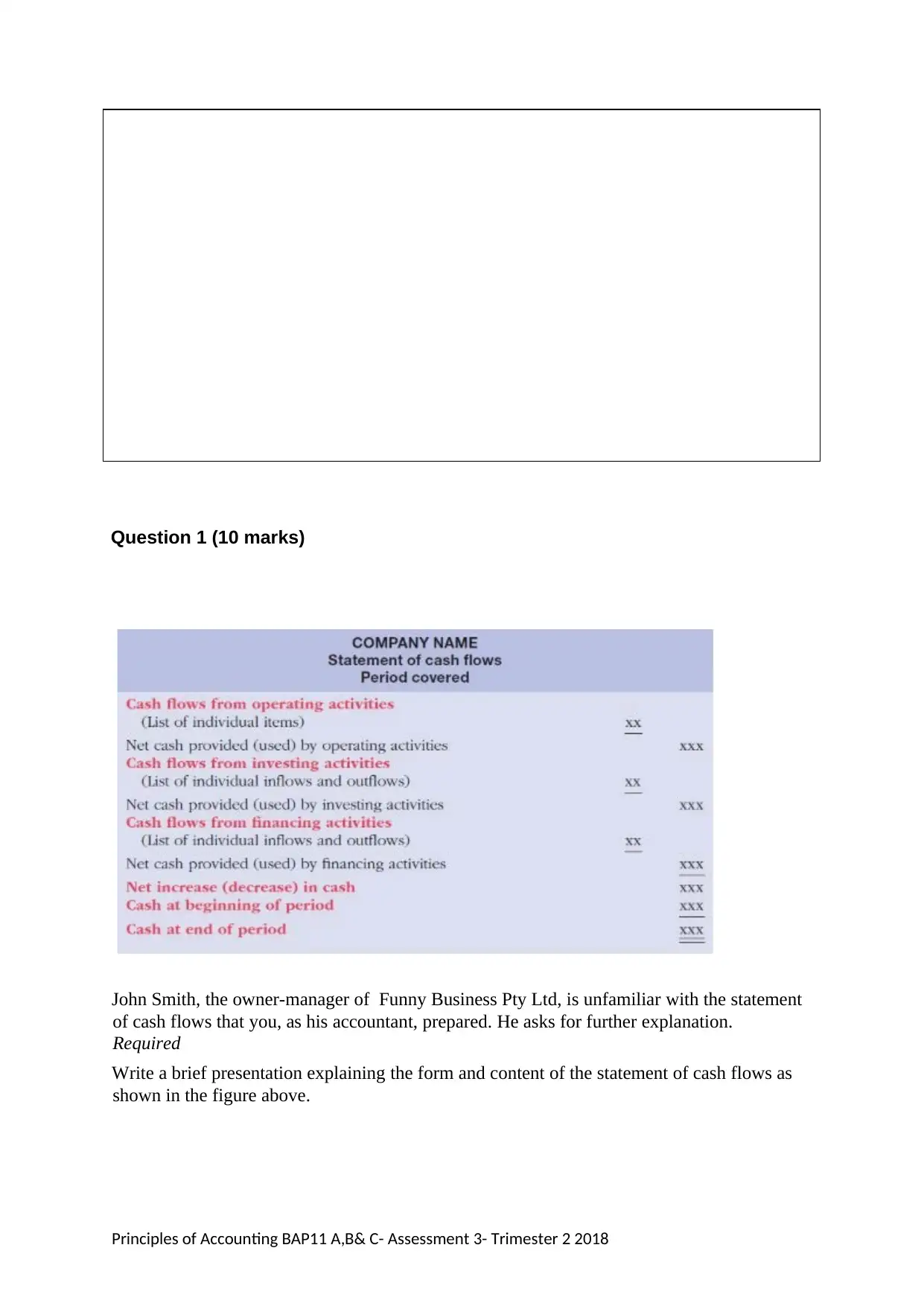
John Smith, the owner-manager of Funny Business Pty Ltd, is unfamiliar with the statement
of cash flows that you, as his accountant, prepared. He asks for further explanation.
Required
Write a brief presentation explaining the form and content of the statement of cash flows as
shown in the figure above.
Principles of Accounting BAP11 A,B& C- Assessment 3- Trimester 2 2018

cash to and from the business of the reporting entity. While preparing the cash flow statements entities do
not have to take into account the non-cash activities or transactions undertaken during the reported period
of time in the course of business. Cash flows statement generally covers three major activities of the
business which results in inflow and outflow of cash from the business. These activities are: operating
activities, investing activities and financing activities. The statement of cash flows bridges the gap between
the statement of income (profit and loss account) and statement of final position (balance sheet). The above
figure depicts that cash flow statement prepared using the direct approach as the cash flows from operating
activities are directly to be shown under the heading of operating activities and not supposed to be adjusted
from the current year’s balance of net income or loss. The possible cash flows from operating activities can
range from cash collection from trade receivables (increase in cash flows), cash payments to the trade
payables (decrease in cash flows), payment of income taxes and other operating expenses (decrease in cash
flows) of the business such as interests, wages and salaries. The said activities are undertaken as a result of
basic business operations and hence often referred as principle activities that produce revenues for the
entity. These activities primarily affect the short term assets and liabilities of the business. Investing activities
are those activities that involve purchase and sale of non-current assets of the business such as plant and
machinery, equipment, furniture and fixtures, motor vehicles, investments that are not covered by cash
equivalents (Higgins, 2012). The disposal of the above mentioned assets increases the flow of cash for the
business and the acquisition of such assets decreases the cash flows. The third item in the above figure
depicts the cash flows from financing activities. Financing activities are those activities that lead to change in
size or composition of firm’s equity capital or its borrowings. Cash flows from financing activities typically
cover repayment of loans taken from banks and financial institutions, issuance of debentures and shares to
raise the capital, buy-back of the entities of the shares. It also includes payment of interest and dividend to
the shareholders and other investors of the company. The borrowings from banks and the raising of funds
through the issuance of shares and debentures increase the cash flows of the business. Further, the
repayments of the same results in cash outflow of the business. The net cash flows from all the three
activities is adjusted to the opening balance of cash or cash equivalents of that year and from the total of
these two items must be equal to the closing cash balance of the business. If the total cash flows along with
the opening balance do not match with the closing cash balance, then it signifies that there is some clerical
or logical error in the preparation of cash flow statement (Brahmasrene, Strupeck & Whitten, 2004).
Principles of Accounting BAP11 A,B& C- Assessment 3- Trimester 2 2018
⊘ This is a preview!⊘
Do you want full access?
Subscribe today to unlock all pages.

Trusted by 1+ million students worldwide
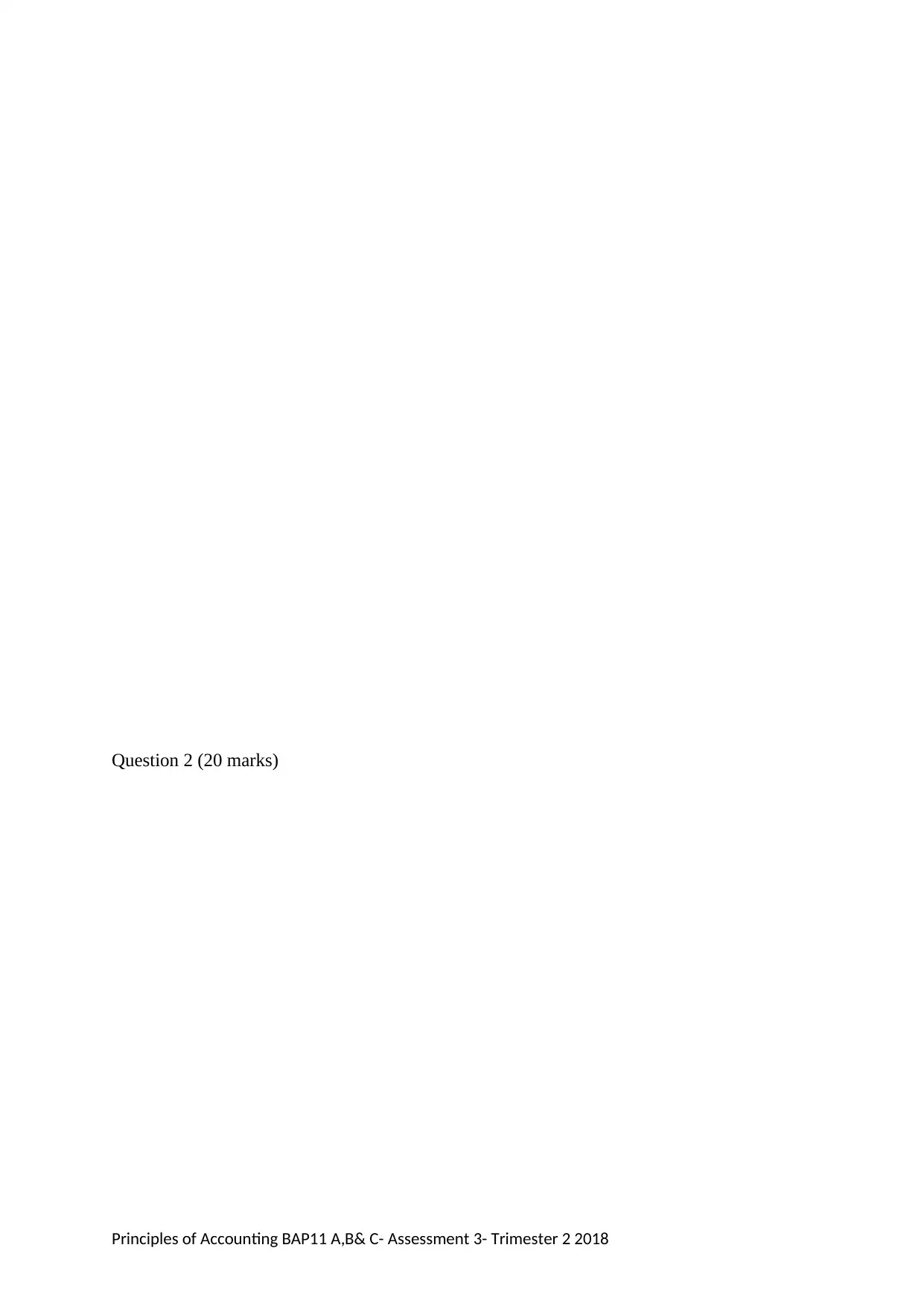
Principles of Accounting BAP11 A,B& C- Assessment 3- Trimester 2 2018
Paraphrase This Document
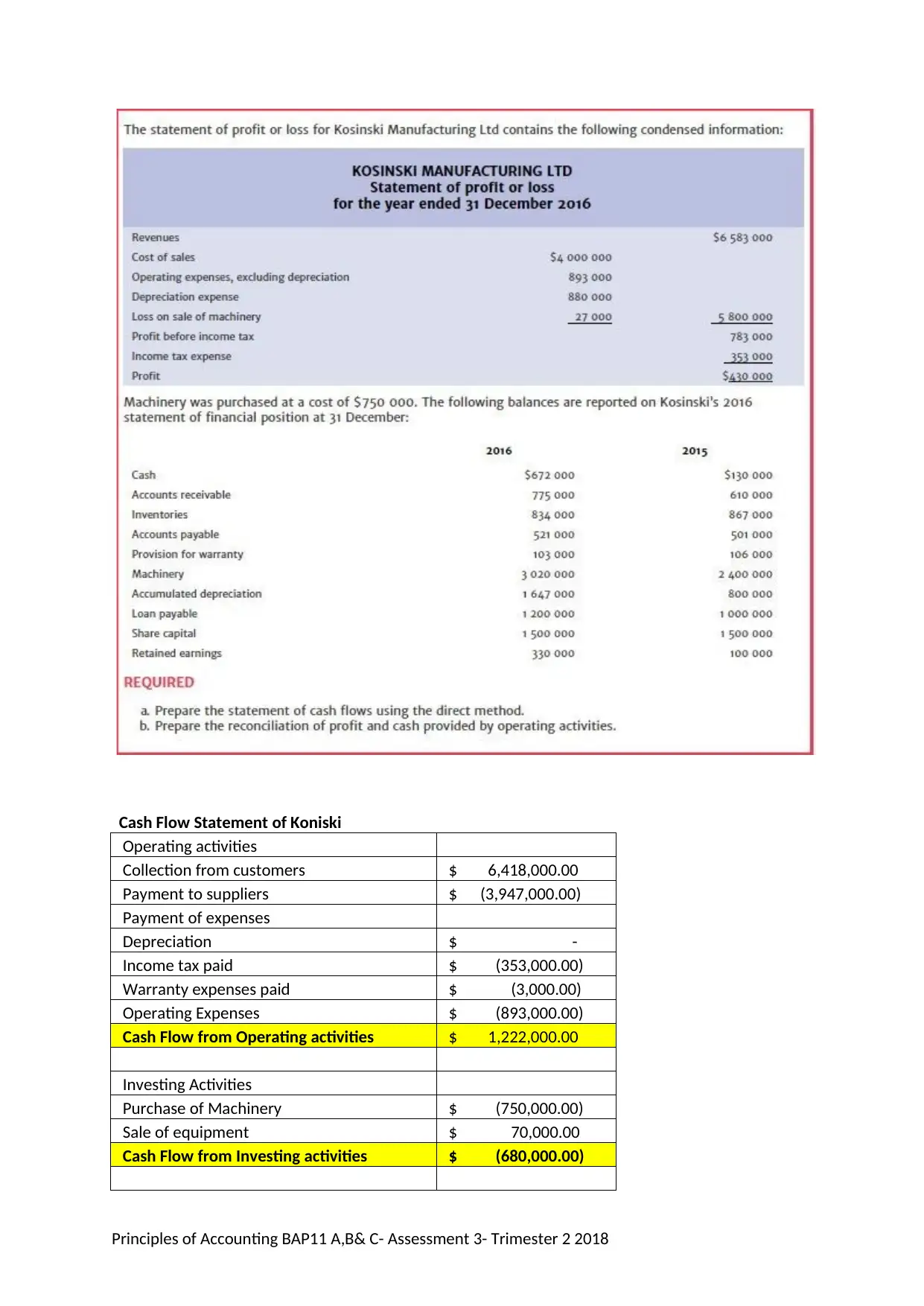
Operating activities
Collection from customers $ 6,418,000.00
Payment to suppliers $ (3,947,000.00)
Payment of expenses
Depreciation $ -
Income tax paid $ (353,000.00)
Warranty expenses paid $ (3,000.00)
Operating Expenses $ (893,000.00)
Cash Flow from Operating activities $ 1,222,000.00
Investing Activities
Purchase of Machinery $ (750,000.00)
Sale of equipment $ 70,000.00
Cash Flow from Investing activities $ (680,000.00)
Principles of Accounting BAP11 A,B& C- Assessment 3- Trimester 2 2018
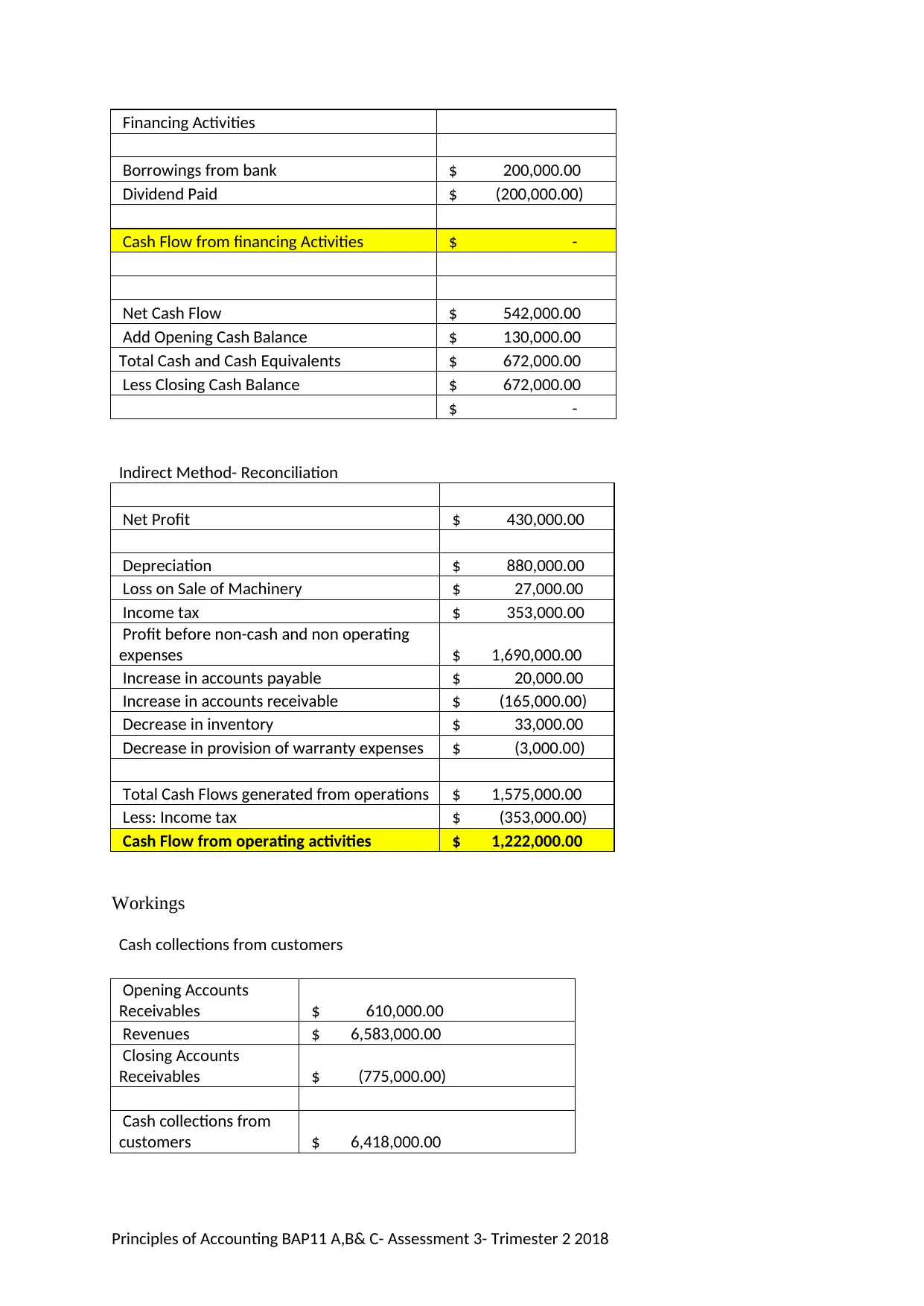
Borrowings from bank $ 200,000.00
Dividend Paid $ (200,000.00)
Cash Flow from financing Activities $ -
Net Cash Flow $ 542,000.00
Add Opening Cash Balance $ 130,000.00
Total Cash and Cash Equivalents $ 672,000.00
Less Closing Cash Balance $ 672,000.00
$ -
Indirect Method- Reconciliation
Net Profit $ 430,000.00
Depreciation $ 880,000.00
Loss on Sale of Machinery $ 27,000.00
Income tax $ 353,000.00
Profit before non-cash and non operating
expenses $ 1,690,000.00
Increase in accounts payable $ 20,000.00
Increase in accounts receivable $ (165,000.00)
Decrease in inventory $ 33,000.00
Decrease in provision of warranty expenses $ (3,000.00)
Total Cash Flows generated from operations $ 1,575,000.00
Less: Income tax $ (353,000.00)
Cash Flow from operating activities $ 1,222,000.00
Workings
Cash collections from customers
Opening Accounts
Receivables $ 610,000.00
Revenues $ 6,583,000.00
Closing Accounts
Receivables $ (775,000.00)
Cash collections from
customers $ 6,418,000.00
Principles of Accounting BAP11 A,B& C- Assessment 3- Trimester 2 2018
⊘ This is a preview!⊘
Do you want full access?
Subscribe today to unlock all pages.

Trusted by 1+ million students worldwide

4000000-(867000-834000)
$ 3,967,000.00
Cash Payment to
Suppliers
Cost of Purchases- Increase in
Accounts Payable
3967000-(521000-501000)
$ 3,947,000.00
Retained Earnings
Opening Balance $ 100,000.00
Net Profit of the year $ 430,000.00
Dividend Paid $ 200,000.00
Closing Balance $ 330,000.00
Machinery
Particulars Amount Particulars Amount
Balance b/d $ 2,400,000.00
Provision for
Depreciation
$
33,000.00
Purchases $ 750,000.00
Loss on sale of
Machinery
$
27,000.00
Bank (Sales)
$
70,000.00
Balance c/d
$
3,020,000.0
0
$ 3,150,000.00
$
3,150,000.0
0
Provision for Depreciation
Machinery $ 33,000.00 Balance b/d
$
800,000.00
Depreciation
Expense
$
880,000.00
Balance c/d $ 1,647,000.00
$ 1,680,000.00 $
1,680,000.0
Principles of Accounting BAP11 A,B& C- Assessment 3- Trimester 2 2018
Paraphrase This Document
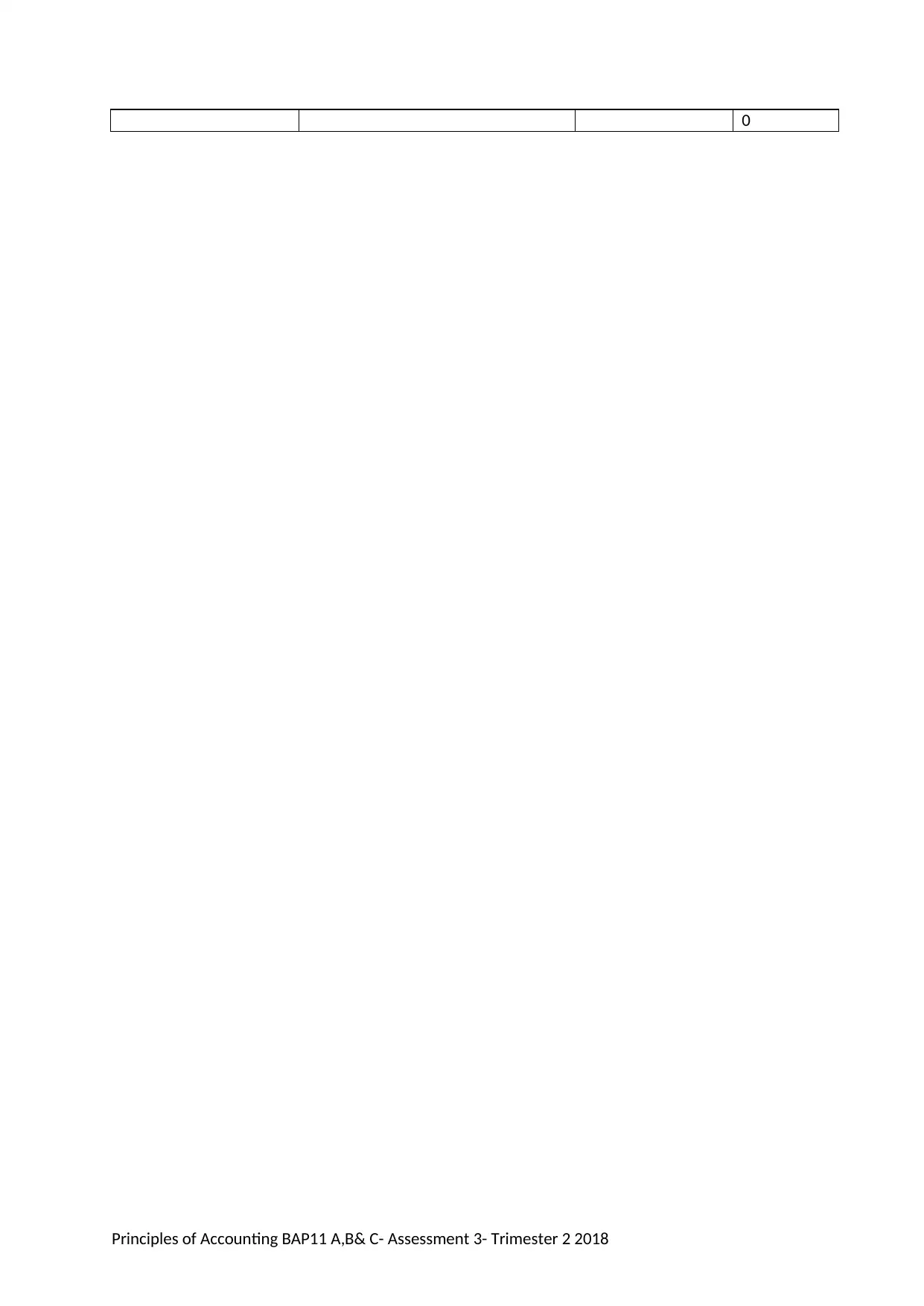
Principles of Accounting BAP11 A,B& C- Assessment 3- Trimester 2 2018
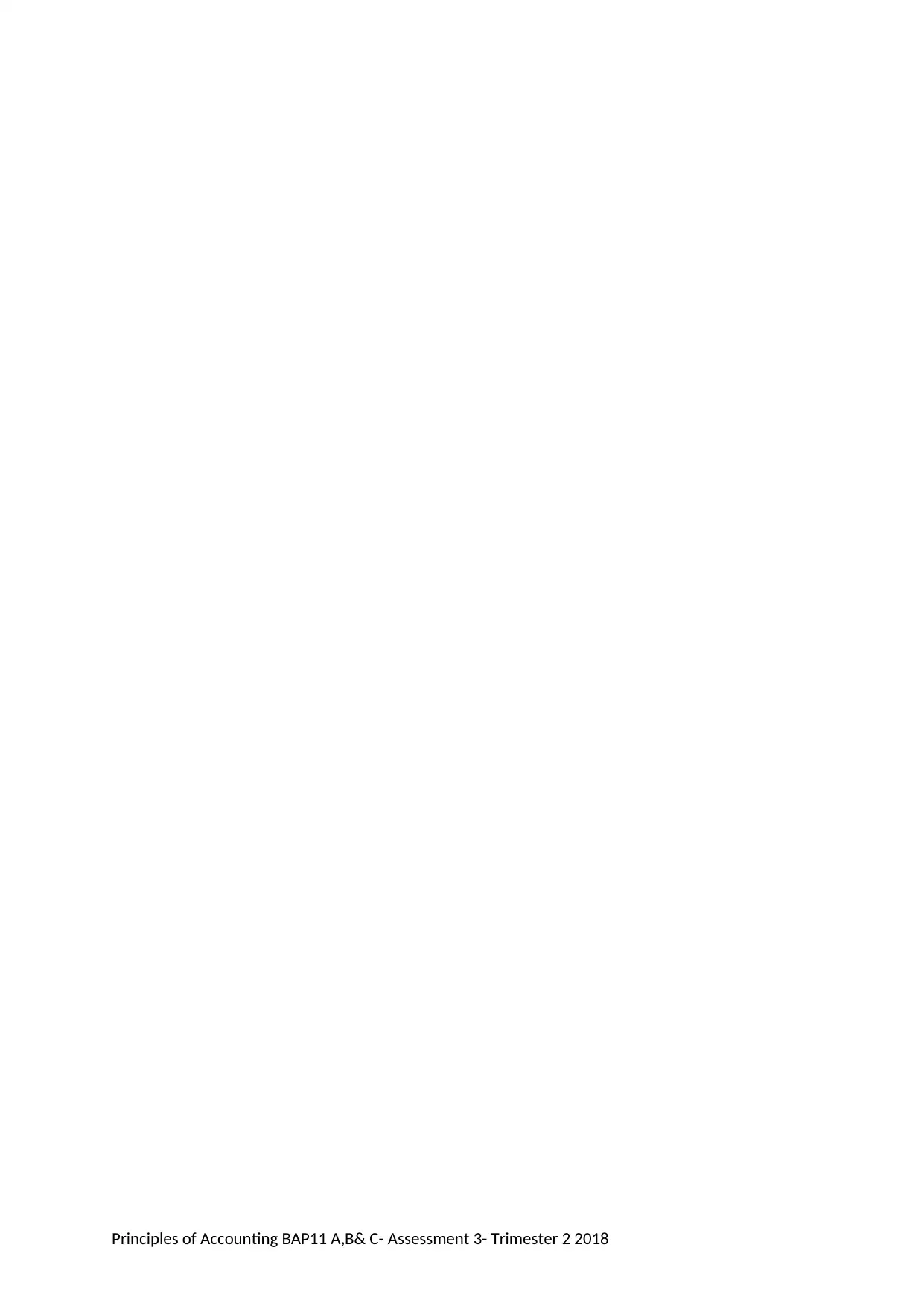
⊘ This is a preview!⊘
Do you want full access?
Subscribe today to unlock all pages.

Trusted by 1+ million students worldwide
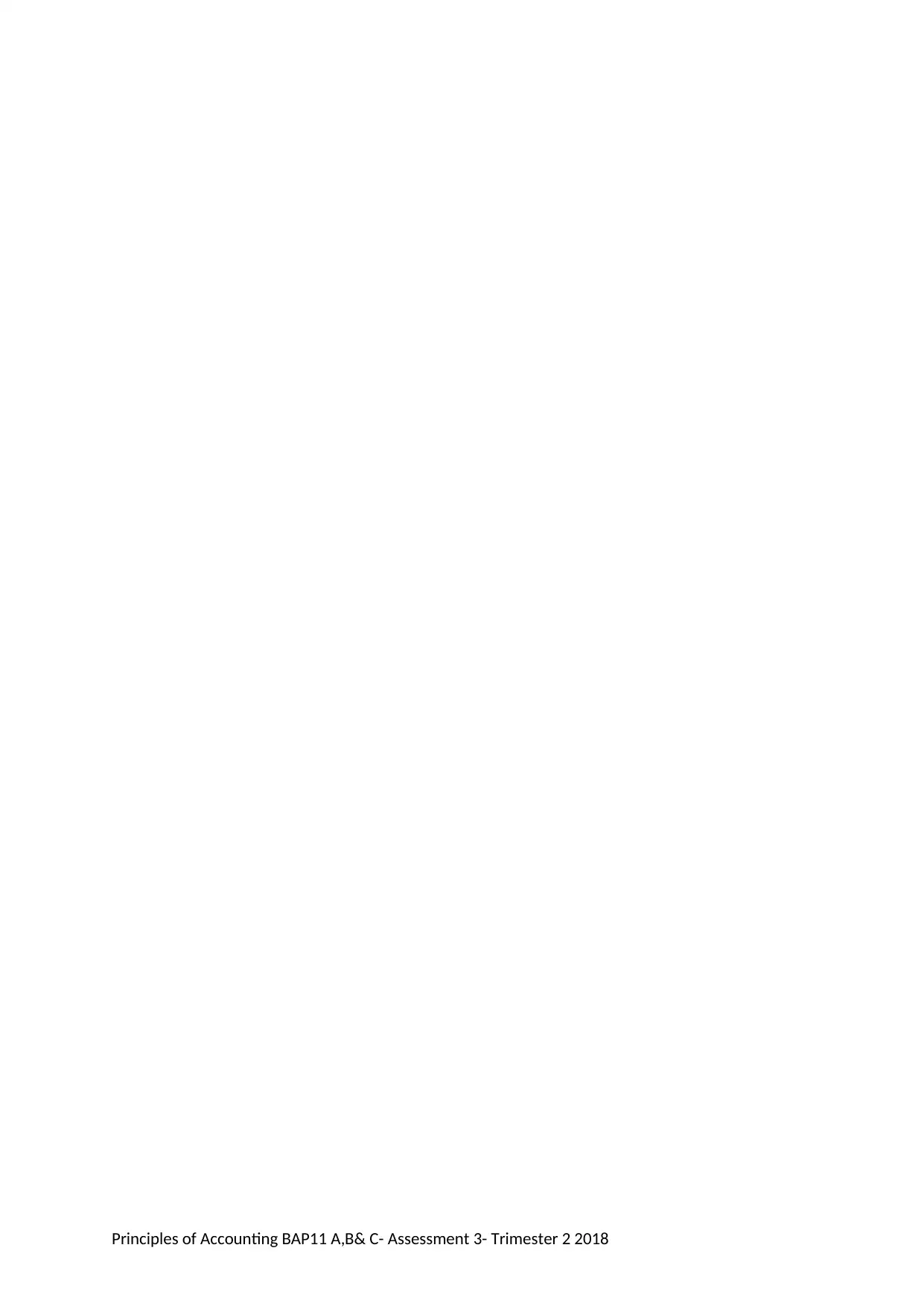
Paraphrase This Document
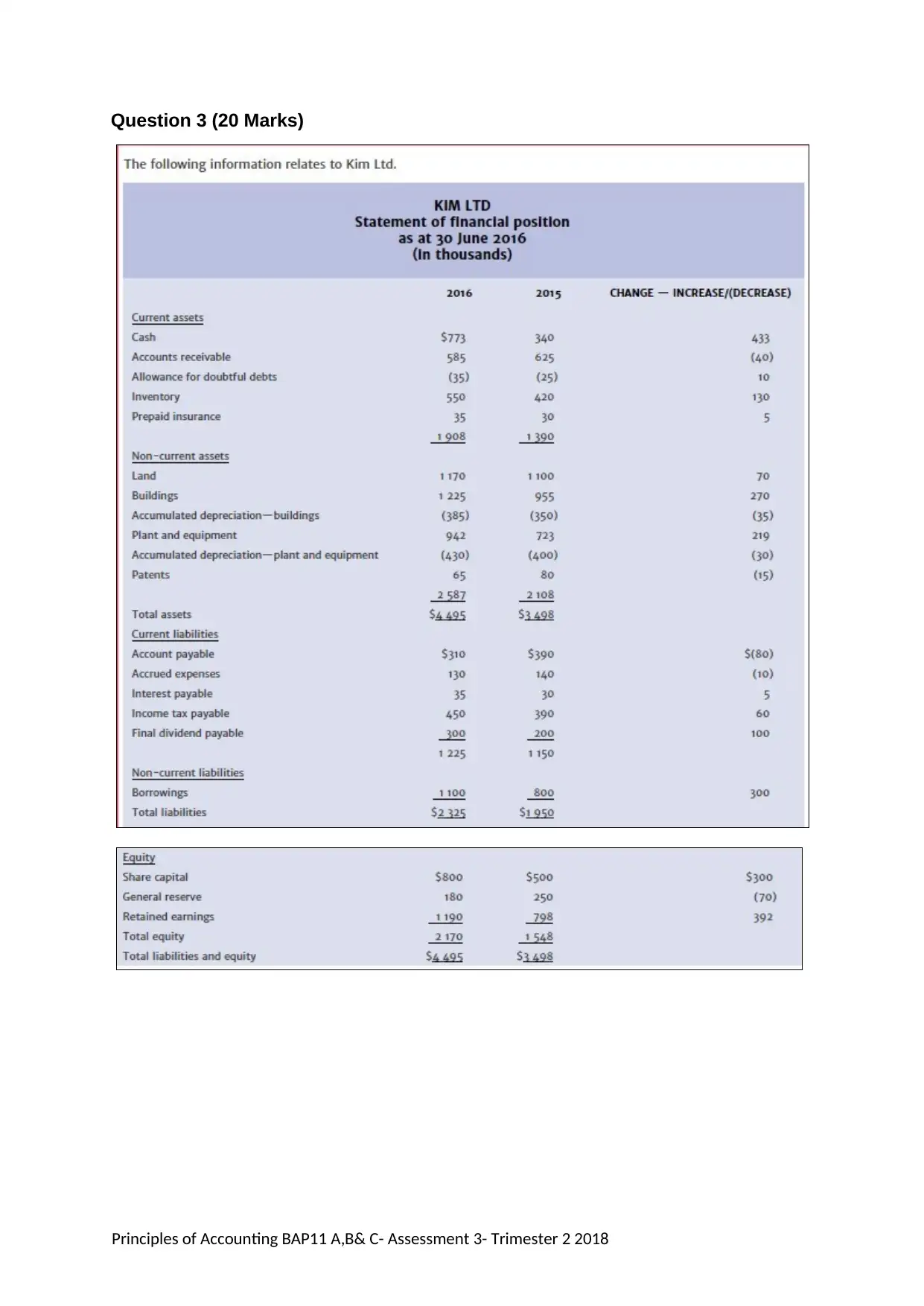
Principles of Accounting BAP11 A,B& C- Assessment 3- Trimester 2 2018

⊘ This is a preview!⊘
Do you want full access?
Subscribe today to unlock all pages.

Trusted by 1+ million students worldwide

Operating Activities
Discount Received $ 15.00
Collection from customers $ 5,080.00
Payment to creditors $ (2,775.00)
Expenses paid $ (1,008.00)
Income Tax $ (450.00)
Other Income $ 170.00
Total Cash Flows from Operating Activities $ 1,032.00
Investing activities
Acquisition of land $ 20.00
Sale of land $ 80.00
Acquisition of equipment $ (319.00)
Sale of equipment $ 65.00
Acquisition of building $ (270.00)
Disposal of Patents $ 15.00
Cash Flows from Investing Activities $ (409.00)
Cash flow from financing activities
Issue of shares $ 200.00
Proceeds from borrowings $ 300.00
Dividend Paid $ (700.00)
Cash flow from financing activities $ (200.00)
Net Cash Flows $ 423.00
Add Opening cash balance $ 340.00
Total cash and cash equivalents $ 773.00
Closing Cash Equivalents $ 773.00
Cash flow from operating activities- Reconciliation
Net Profit $ 1,022.00
Add Non Cash and non operating expenses
Depreciation $ 130.00
Amortization $ 15.00
Income Tax $ 450.00
Less
Gain on sale of land $ (75.00)
Gain on sale of building $ (30.00)
$ 1,512.00
Add Decrease in current assets and increase in
liabilities
Interest Payable $ 5.00
Principles of Accounting BAP11 A,B& C- Assessment 3- Trimester 2 2018
Paraphrase This Document
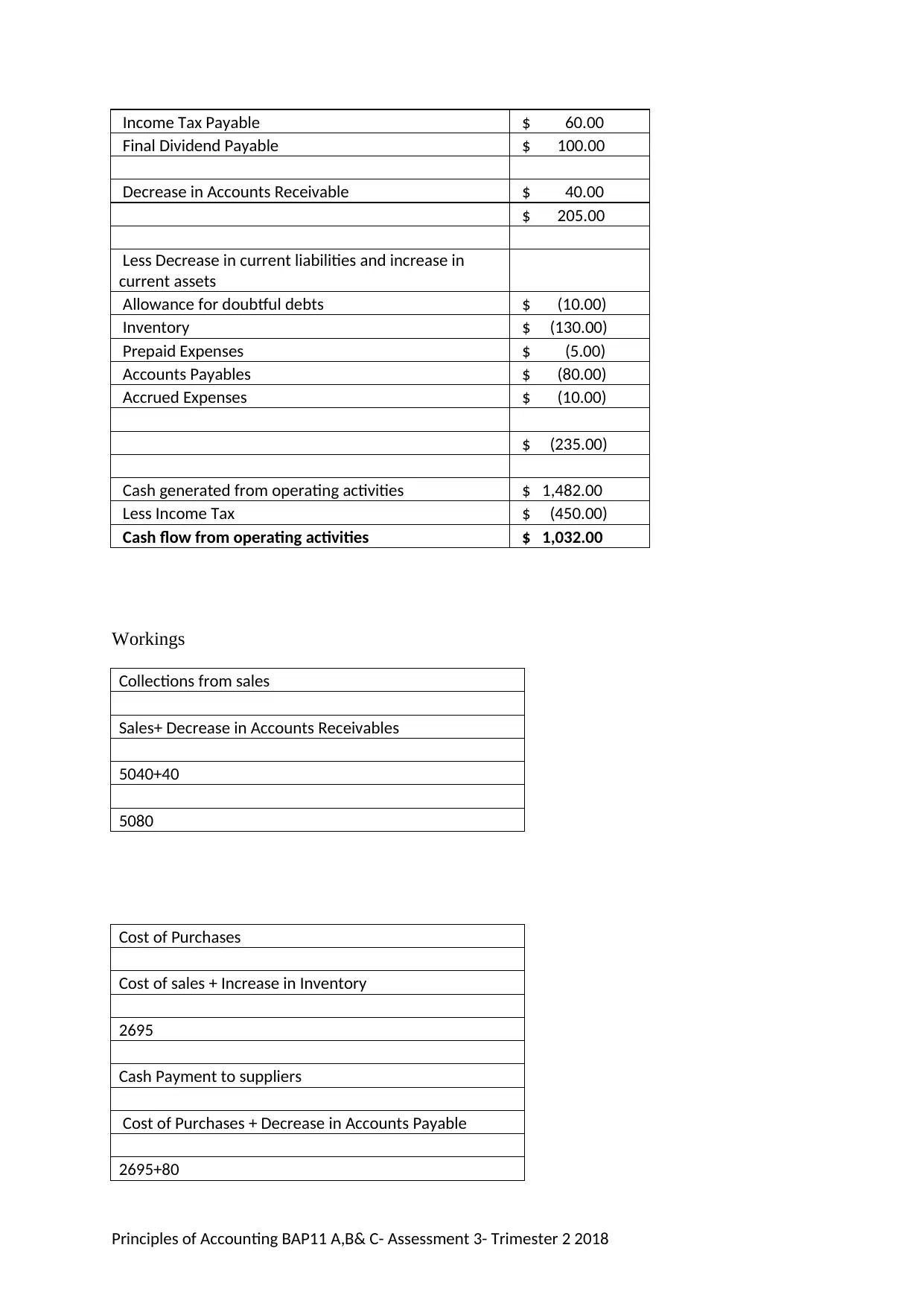
Final Dividend Payable $ 100.00
Decrease in Accounts Receivable $ 40.00
$ 205.00
Less Decrease in current liabilities and increase in
current assets
Allowance for doubtful debts $ (10.00)
Inventory $ (130.00)
Prepaid Expenses $ (5.00)
Accounts Payables $ (80.00)
Accrued Expenses $ (10.00)
$ (235.00)
Cash generated from operating activities $ 1,482.00
Less Income Tax $ (450.00)
Cash flow from operating activities $ 1,032.00
Workings
Collections from sales
Sales+ Decrease in Accounts Receivables
5040+40
5080
Cost of Purchases
Cost of sales + Increase in Inventory
2695
Cash Payment to suppliers
Cost of Purchases + Decrease in Accounts Payable
2695+80
Principles of Accounting BAP11 A,B& C- Assessment 3- Trimester 2 2018

Retained Earnings Account
Opening Balance 798
Net Income 1022
Add: Amount withdrawn from reserves 70
Dividend paid 700
Closing Balance 1190
Land
Opening 1100 Sale 80
Acquisition through shares 100
Gain on sale of land 30
Acquisition through cash 20
Closing 1170
1250 1250
Equipment
Opening Balance 723
Accumulated
Depreciation 65
Gain on sale of equipment 30 Sale of equipment 65
Purchases 319
Closing Balance 942
1072 1072
Accumulated Depreciation
Plant and Equipment 65 Opening 400
Depreciation Expense 95
Closing 430
495 495
Building
Opening Balance 955
Accumulated
Depreciation 0
Purchases 270
Closing Balance 1225
1225 1225
Principles of Accounting BAP11 A,B& C- Assessment 3- Trimester 2 2018
⊘ This is a preview!⊘
Do you want full access?
Subscribe today to unlock all pages.

Trusted by 1+ million students worldwide
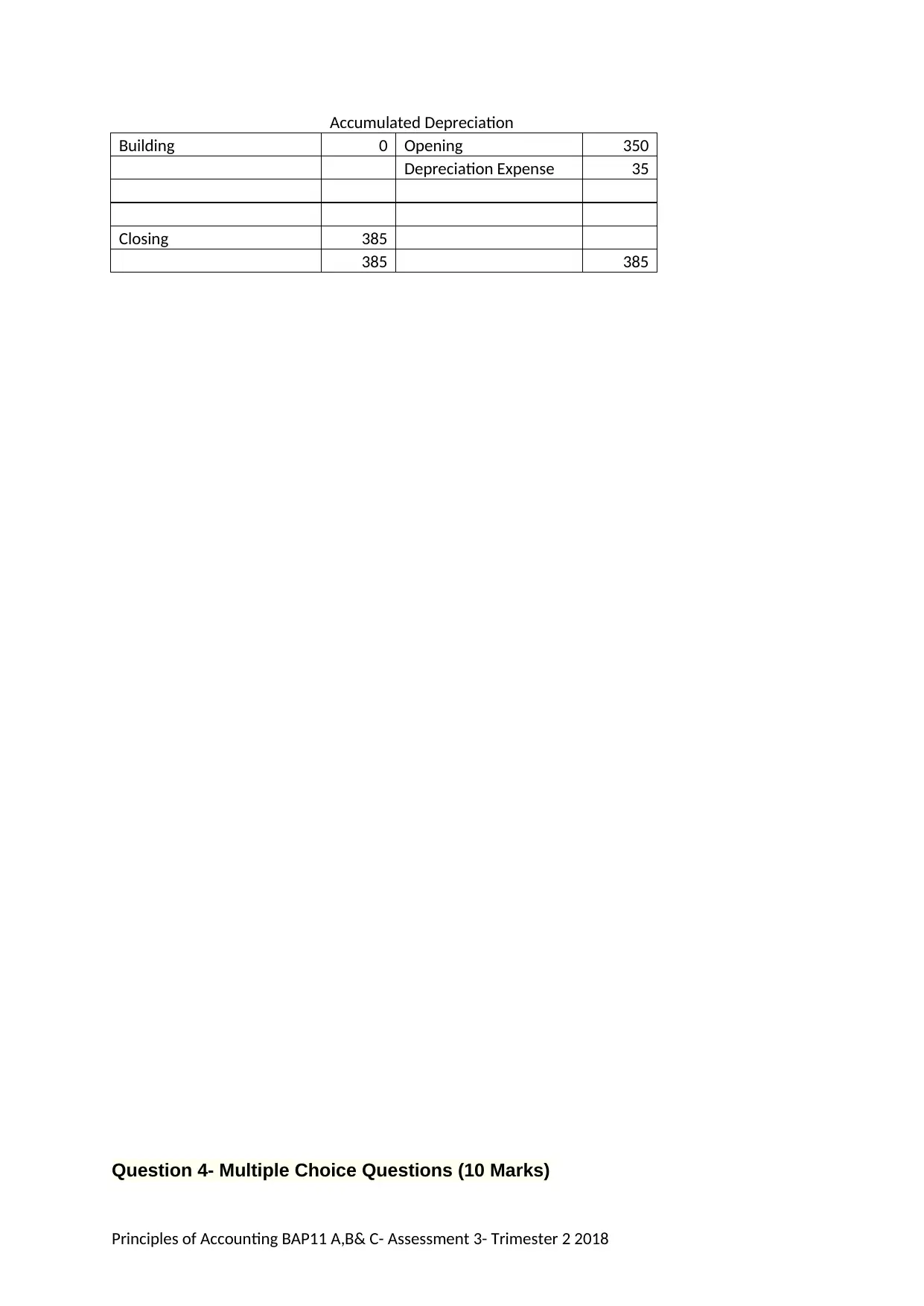
Building 0 Opening 350
Depreciation Expense 35
Closing 385
385 385
Question 4- Multiple Choice Questions (10 Marks)
Principles of Accounting BAP11 A,B& C- Assessment 3- Trimester 2 2018
Paraphrase This Document
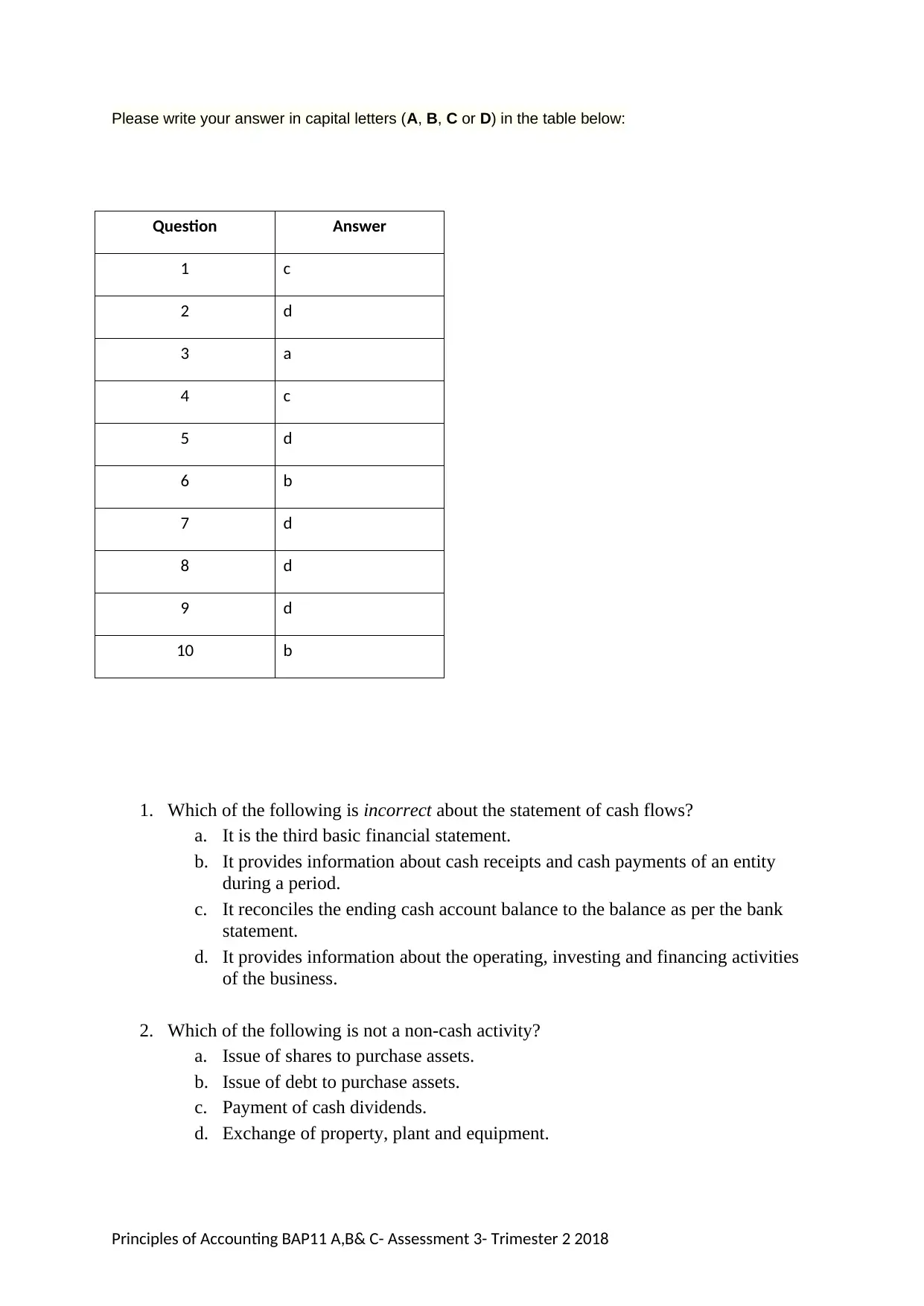
Question Answer
1 c
2 d
3 a
4 c
5 d
6 b
7 d
8 d
9 d
10 b
1. Which of the following is incorrect about the statement of cash flows?
a. It is the third basic financial statement.
b. It provides information about cash receipts and cash payments of an entity
during a period.
c. It reconciles the ending cash account balance to the balance as per the bank
statement.
d. It provides information about the operating, investing and financing activities
of the business.
2. Which of the following is not a non-cash activity?
a. Issue of shares to purchase assets.
b. Issue of debt to purchase assets.
c. Payment of cash dividends.
d. Exchange of property, plant and equipment.
Principles of Accounting BAP11 A,B& C- Assessment 3- Trimester 2 2018
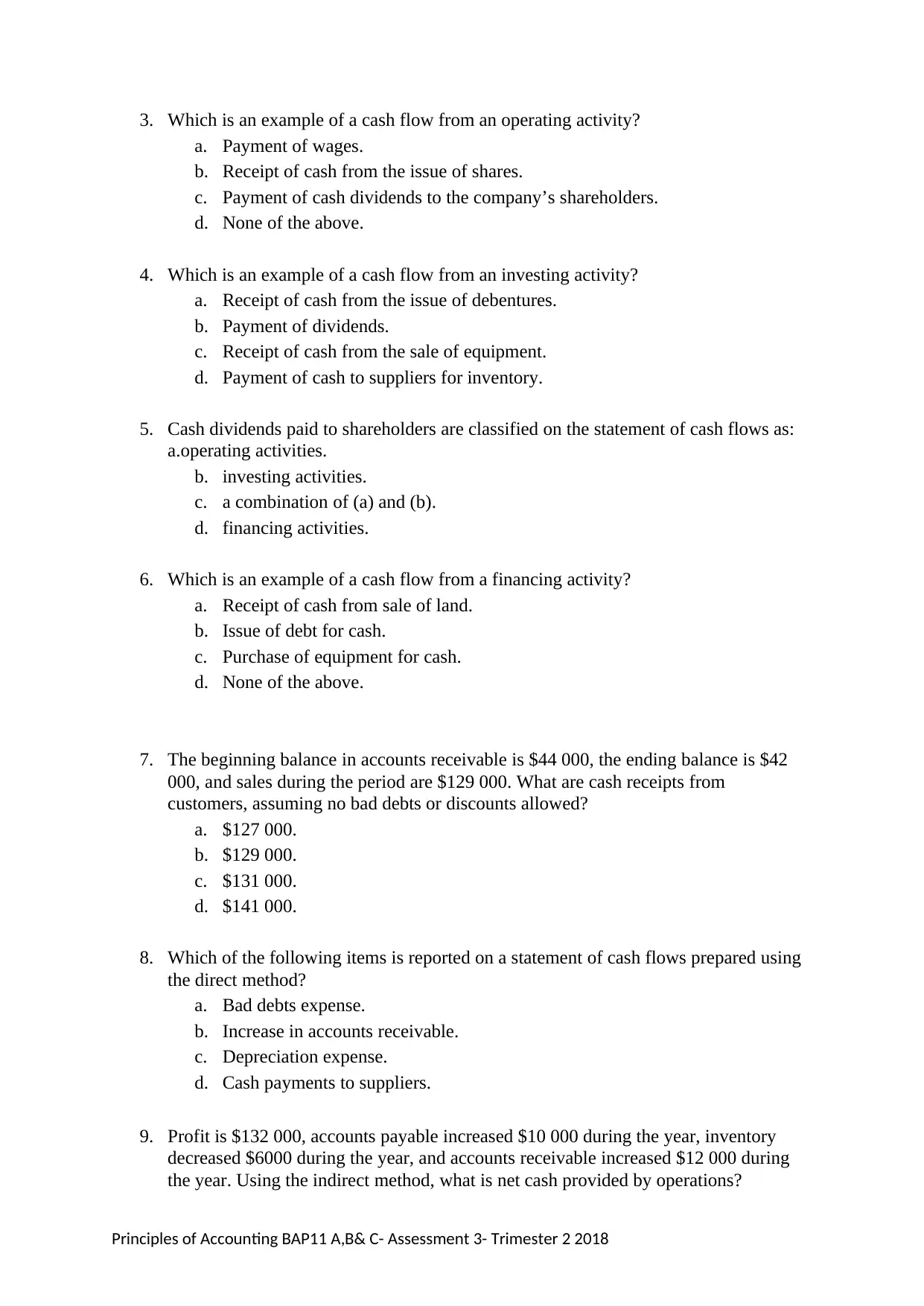
a. Payment of wages.
b. Receipt of cash from the issue of shares.
c. Payment of cash dividends to the company’s shareholders.
d. None of the above.
4. Which is an example of a cash flow from an investing activity?
a. Receipt of cash from the issue of debentures.
b. Payment of dividends.
c. Receipt of cash from the sale of equipment.
d. Payment of cash to suppliers for inventory.
5. Cash dividends paid to shareholders are classified on the statement of cash flows as:
a.operating activities.
b. investing activities.
c. a combination of (a) and (b).
d. financing activities.
6. Which is an example of a cash flow from a financing activity?
a. Receipt of cash from sale of land.
b. Issue of debt for cash.
c. Purchase of equipment for cash.
d. None of the above.
7. The beginning balance in accounts receivable is $44 000, the ending balance is $42
000, and sales during the period are $129 000. What are cash receipts from
customers, assuming no bad debts or discounts allowed?
a. $127 000.
b. $129 000.
c. $131 000.
d. $141 000.
8. Which of the following items is reported on a statement of cash flows prepared using
the direct method?
a. Bad debts expense.
b. Increase in accounts receivable.
c. Depreciation expense.
d. Cash payments to suppliers.
9. Profit is $132 000, accounts payable increased $10 000 during the year, inventory
decreased $6000 during the year, and accounts receivable increased $12 000 during
the year. Using the indirect method, what is net cash provided by operations?
Principles of Accounting BAP11 A,B& C- Assessment 3- Trimester 2 2018
⊘ This is a preview!⊘
Do you want full access?
Subscribe today to unlock all pages.

Trusted by 1+ million students worldwide
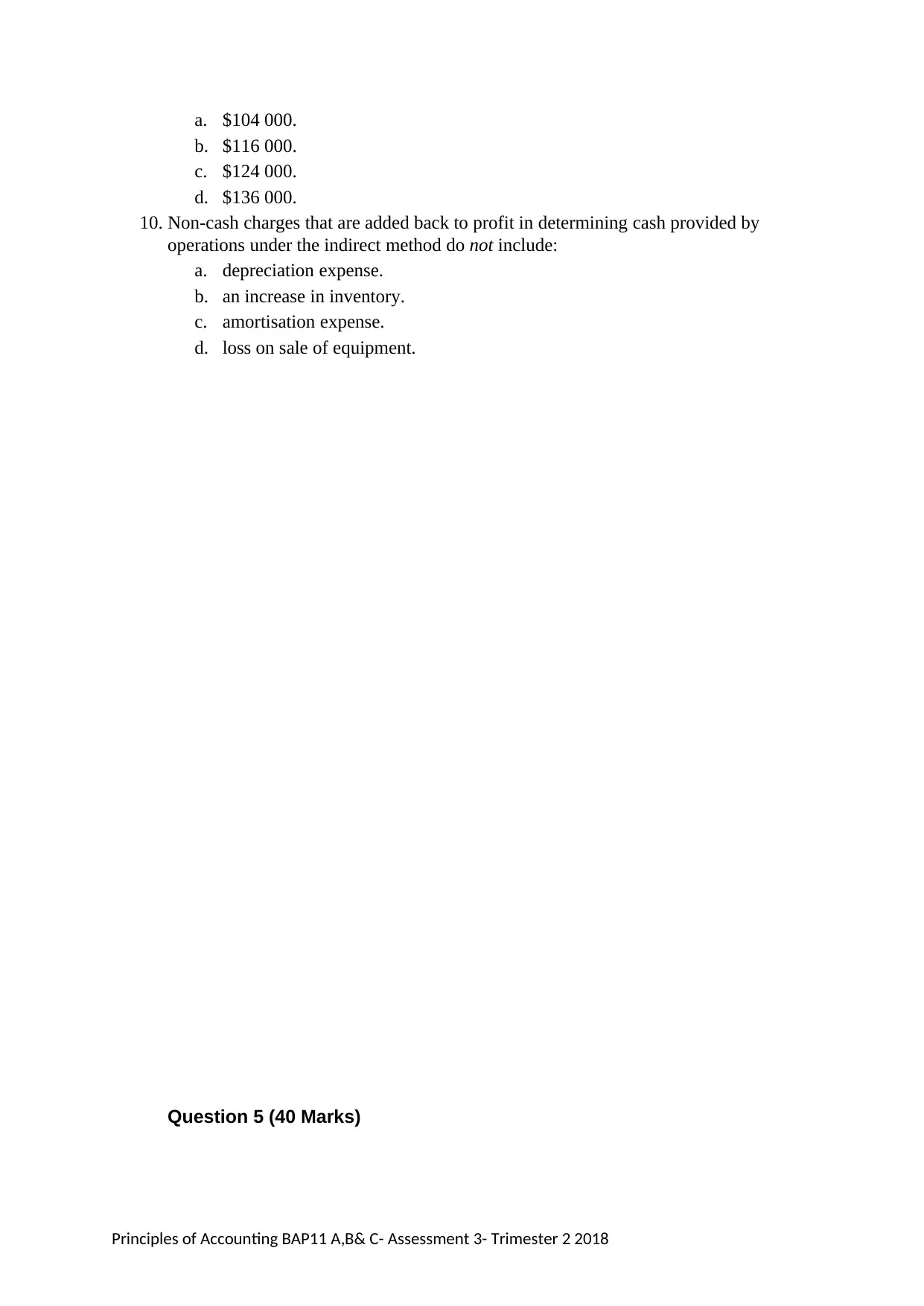
b. $116 000.
c. $124 000.
d. $136 000.
10. Non-cash charges that are added back to profit in determining cash provided by
operations under the indirect method do not include:
a. depreciation expense.
b. an increase in inventory.
c. amortisation expense.
d. loss on sale of equipment.
Question 5 (40 Marks)
Principles of Accounting BAP11 A,B& C- Assessment 3- Trimester 2 2018
Paraphrase This Document
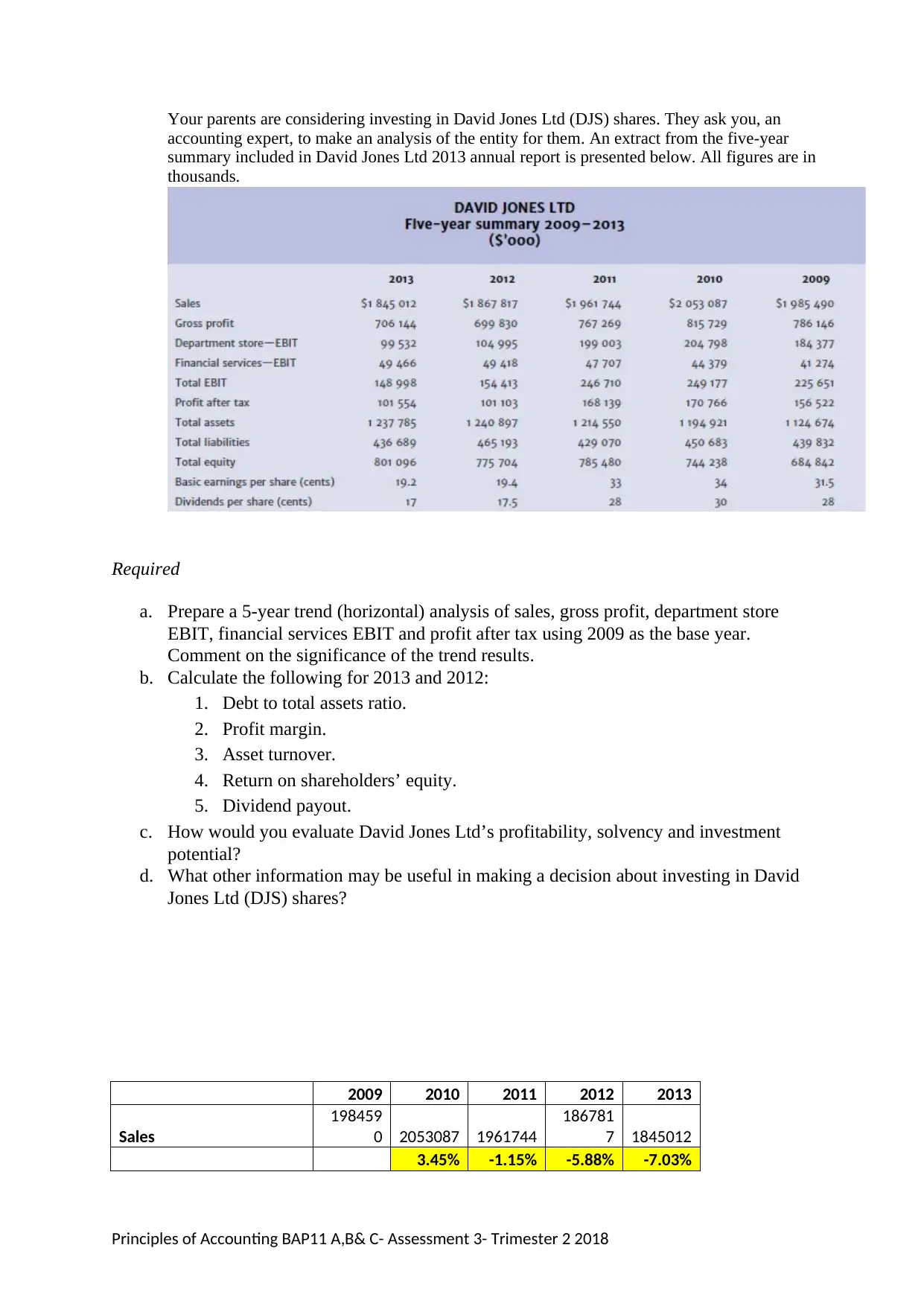
accounting expert, to make an analysis of the entity for them. An extract from the five-year
summary included in David Jones Ltd 2013 annual report is presented below. All figures are in
thousands.
Required
a. Prepare a 5-year trend (horizontal) analysis of sales, gross profit, department store
EBIT, financial services EBIT and profit after tax using 2009 as the base year.
Comment on the significance of the trend results.
b. Calculate the following for 2013 and 2012:
1. Debt to total assets ratio.
2. Profit margin.
3. Asset turnover.
4. Return on shareholders’ equity.
5. Dividend payout.
c. How would you evaluate David Jones Ltd’s profitability, solvency and investment
potential?
d. What other information may be useful in making a decision about investing in David
Jones Ltd (DJS) shares?
2009 2010 2011 2012 2013
Sales
198459
0 2053087 1961744
186781
7 1845012
3.45% -1.15% -5.88% -7.03%
Principles of Accounting BAP11 A,B& C- Assessment 3- Trimester 2 2018
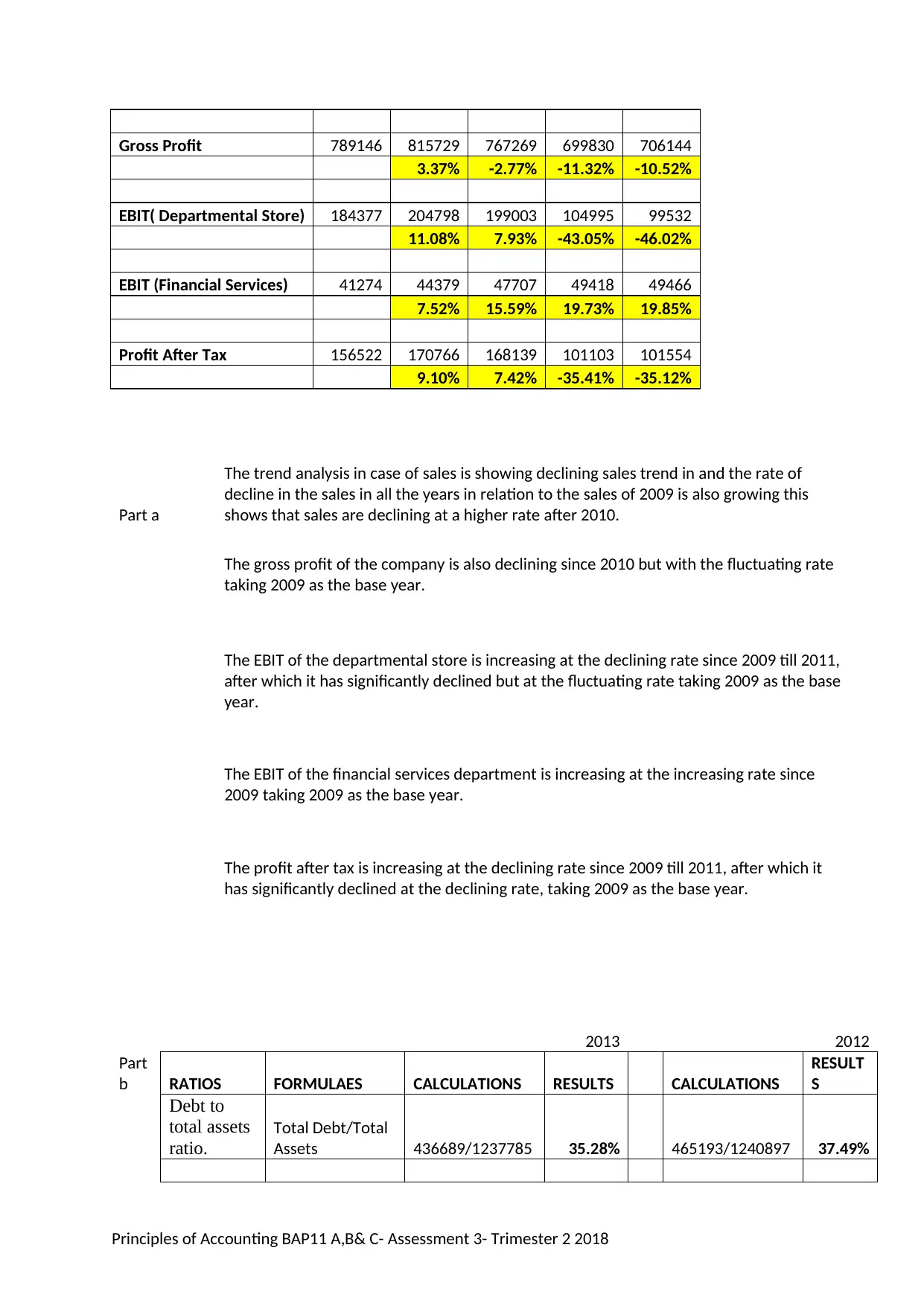
3.37% -2.77% -11.32% -10.52%
EBIT( Departmental Store) 184377 204798 199003 104995 99532
11.08% 7.93% -43.05% -46.02%
EBIT (Financial Services) 41274 44379 47707 49418 49466
7.52% 15.59% 19.73% 19.85%
Profit After Tax 156522 170766 168139 101103 101554
9.10% 7.42% -35.41% -35.12%
Part a
The trend analysis in case of sales is showing declining sales trend in and the rate of
decline in the sales in all the years in relation to the sales of 2009 is also growing this
shows that sales are declining at a higher rate after 2010.
The gross profit of the company is also declining since 2010 but with the fluctuating rate
taking 2009 as the base year.
The EBIT of the departmental store is increasing at the declining rate since 2009 till 2011,
after which it has significantly declined but at the fluctuating rate taking 2009 as the base
year.
The EBIT of the financial services department is increasing at the increasing rate since
2009 taking 2009 as the base year.
The profit after tax is increasing at the declining rate since 2009 till 2011, after which it
has significantly declined at the declining rate, taking 2009 as the base year.
2013 2012
Part
b RATIOS FORMULAES CALCULATIONS RESULTS CALCULATIONS
RESULT
S
Debt to
total assets
ratio.
Total Debt/Total
Assets 436689/1237785 35.28% 465193/1240897 37.49%
Principles of Accounting BAP11 A,B& C- Assessment 3- Trimester 2 2018
⊘ This is a preview!⊘
Do you want full access?
Subscribe today to unlock all pages.

Trusted by 1+ million students worldwide

margin.
Net Profit/ Net
Sales 101554/1845012 5.50% 101103/1867817 5.41%
Asset
turnover.
Net Sales/
Average Assets
1845012/
((1240897+12377
85)*0.50) 1.49
1867817/
((1214550+12408
97)*.50) 1.52
Return on
shareholder
s’ equity.
Net Income/
Average
Shareholder's
Equity
101544/
((775704+801096
)*0.50) 12.88%
101103/
((785480+775704
)*.50) 12.95%
Dividend
payout DPS/EPS 17/19.2 88.54% 17.5/19.4 90.21%
Part c Profitability:
The profitability position of David Jones Ltd has improved in 2013 as compared to 2012 and
it is depicted by higher profit margin ratio. It indicates that in 2013, company has earned
higher profits but it still it cannot be said that the profitability position has improved much
since 2012 ROE and dividend payout ratio have not increased (Foster, 2004).
Solvency:
The solvency position of the company seems to have improved to some extent in 2013 as
depicted by lower debt to asset ratio of 2013 than that of 2012. It indicates that the
financial risk of insolvency of company has reduced because of decrease in the external
debts.
Investment Potential:
The investment potential of David Jones Ltd. is good enough as it is paying high returns to
its shareholders. However, the decline in payout ratio in 2013 when compared to 2012
indicates that the return potential of company has reduced in 2013.
Part d
While deciding about the investments to be made in David Jones through shares, the
potential investors must also take into consideration the market price of the shares as it
will allow them to determine the company's worth in the market (Penman & Penman,
2007).
Principles of Accounting BAP11 A,B& C- Assessment 3- Trimester 2 2018
Paraphrase This Document
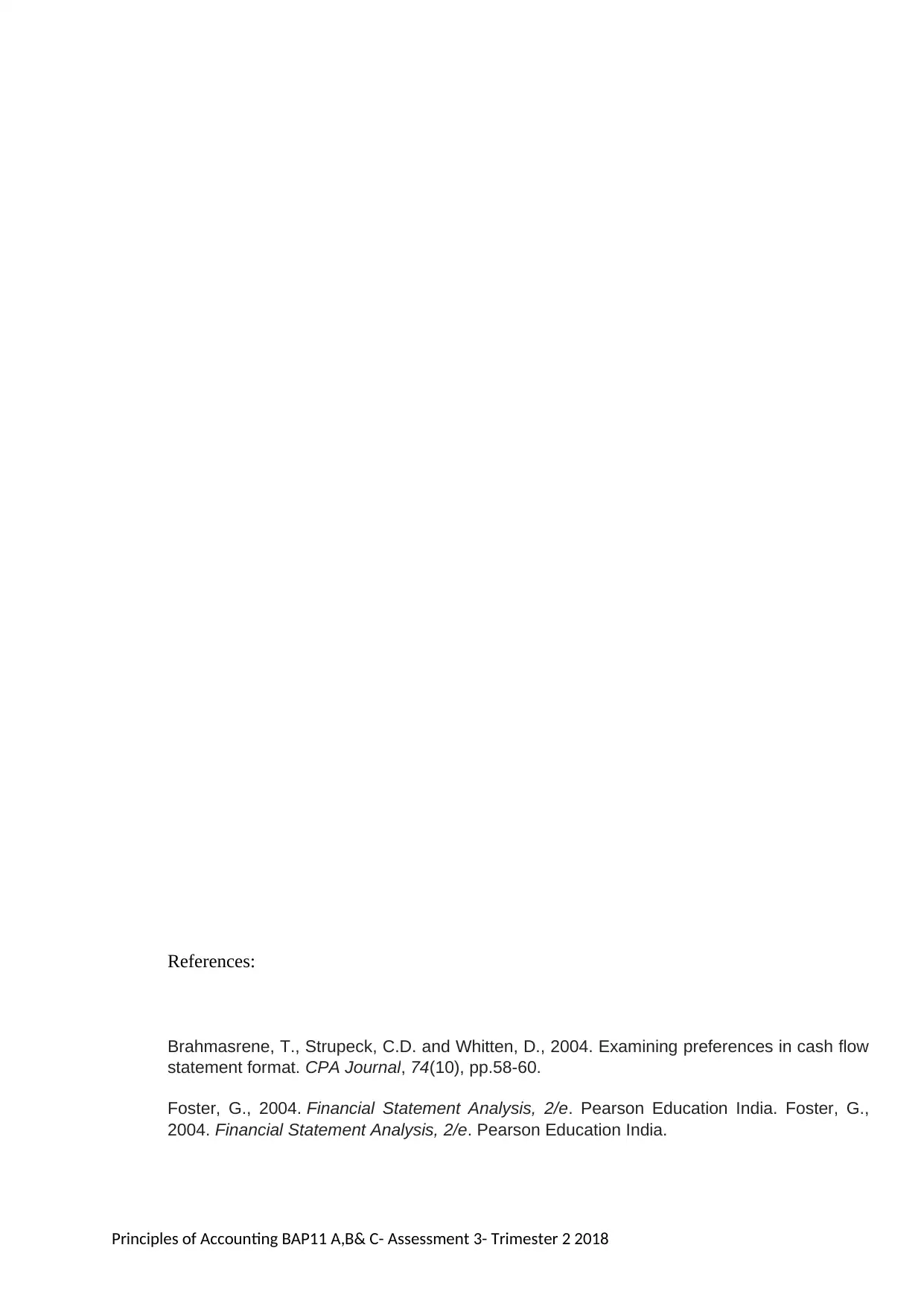
Brahmasrene, T., Strupeck, C.D. and Whitten, D., 2004. Examining preferences in cash flow
statement format. CPA Journal, 74(10), pp.58-60.
Foster, G., 2004. Financial Statement Analysis, 2/e. Pearson Education India. Foster, G.,
2004. Financial Statement Analysis, 2/e. Pearson Education India.
Principles of Accounting BAP11 A,B& C- Assessment 3- Trimester 2 2018
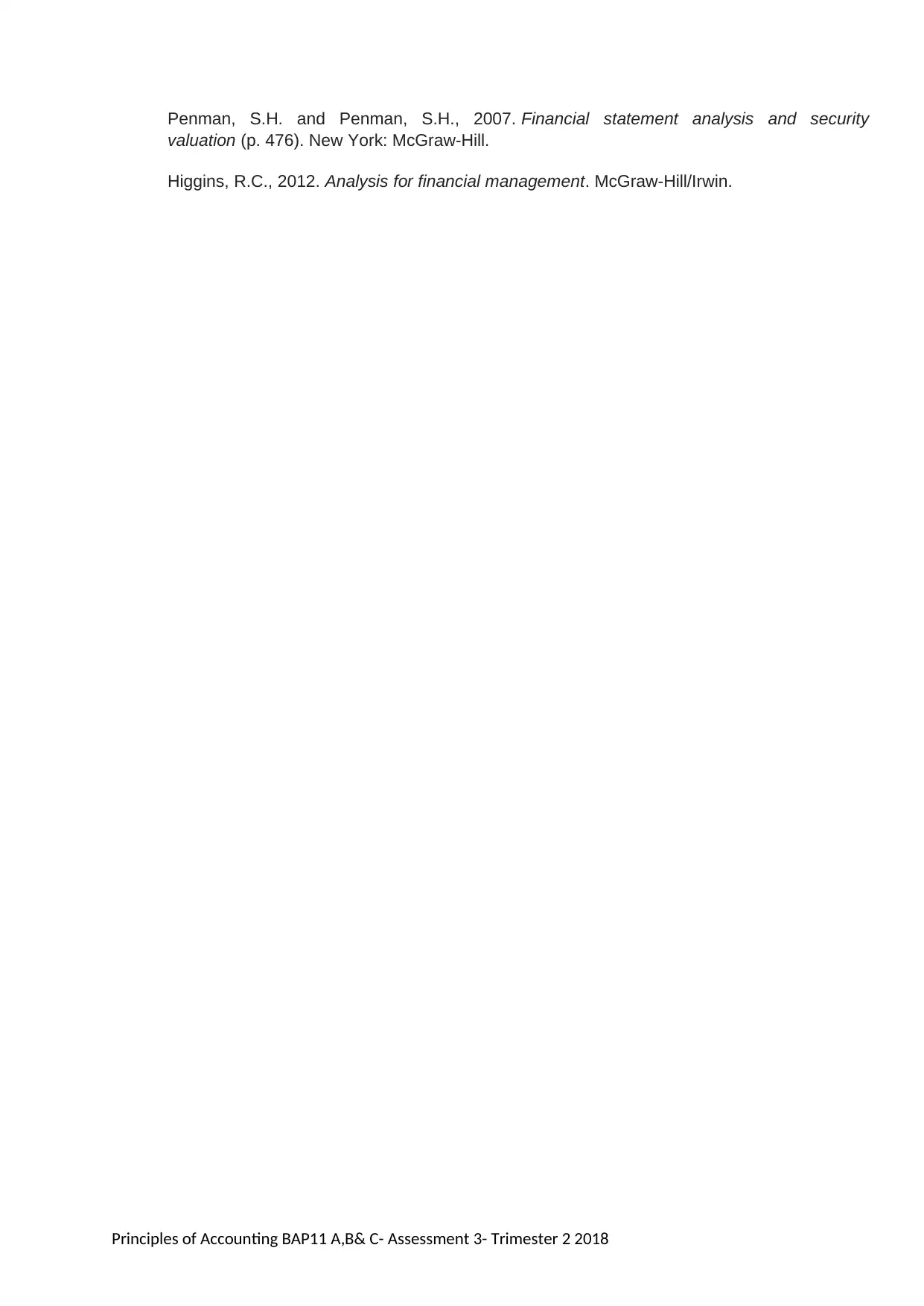
valuation (p. 476). New York: McGraw-Hill.
Higgins, R.C., 2012. Analysis for financial management. McGraw-Hill/Irwin.
Principles of Accounting BAP11 A,B& C- Assessment 3- Trimester 2 2018
⊘ This is a preview!⊘
Do you want full access?
Subscribe today to unlock all pages.

Trusted by 1+ million students worldwide
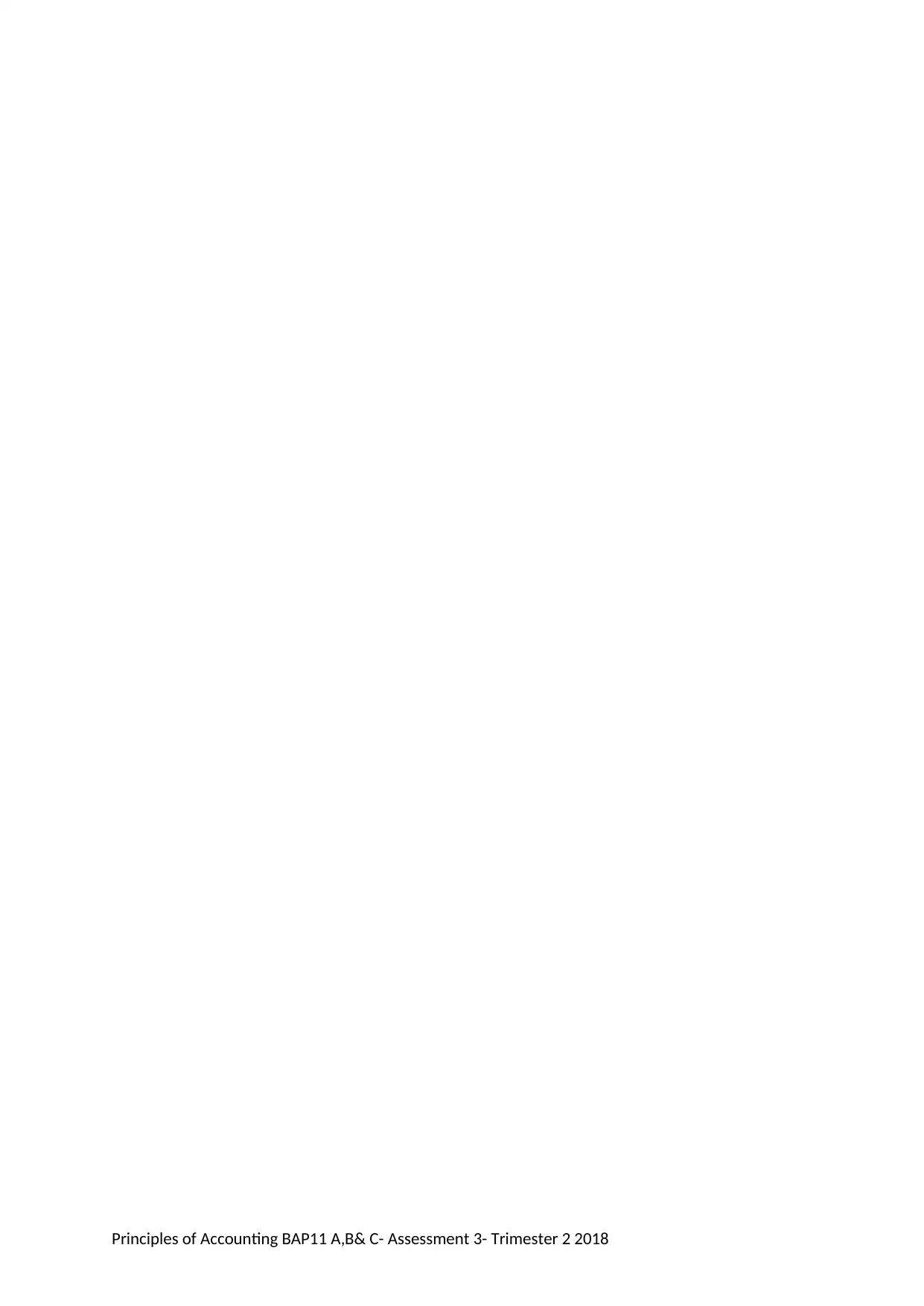
Paraphrase This Document
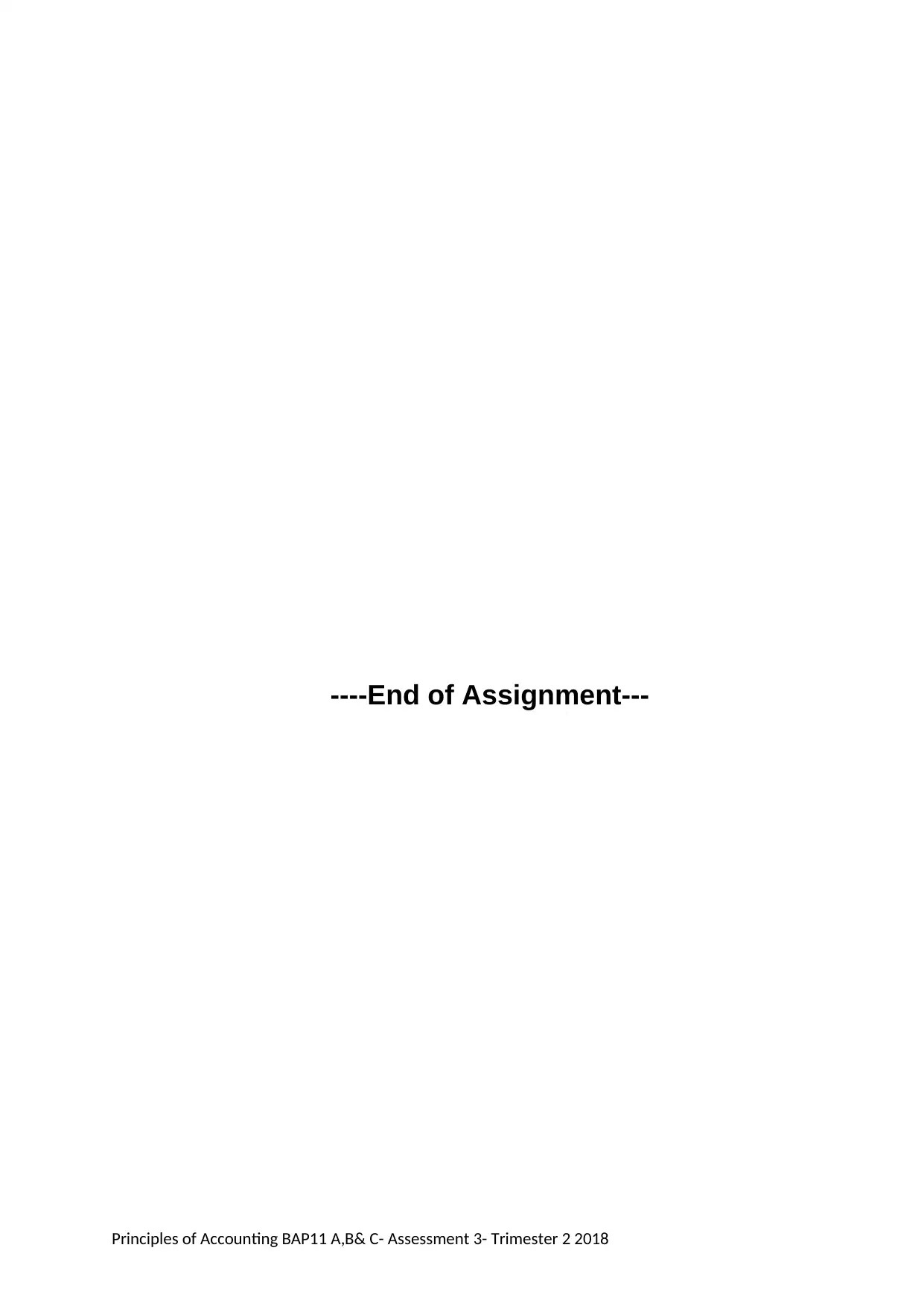
Principles of Accounting BAP11 A,B& C- Assessment 3- Trimester 2 2018
Related Documents
Your All-in-One AI-Powered Toolkit for Academic Success.
+13062052269
info@desklib.com
Available 24*7 on WhatsApp / Email
![[object Object]](/_next/static/media/star-bottom.7253800d.svg)
© 2024 | Zucol Services PVT LTD | All rights reserved.





